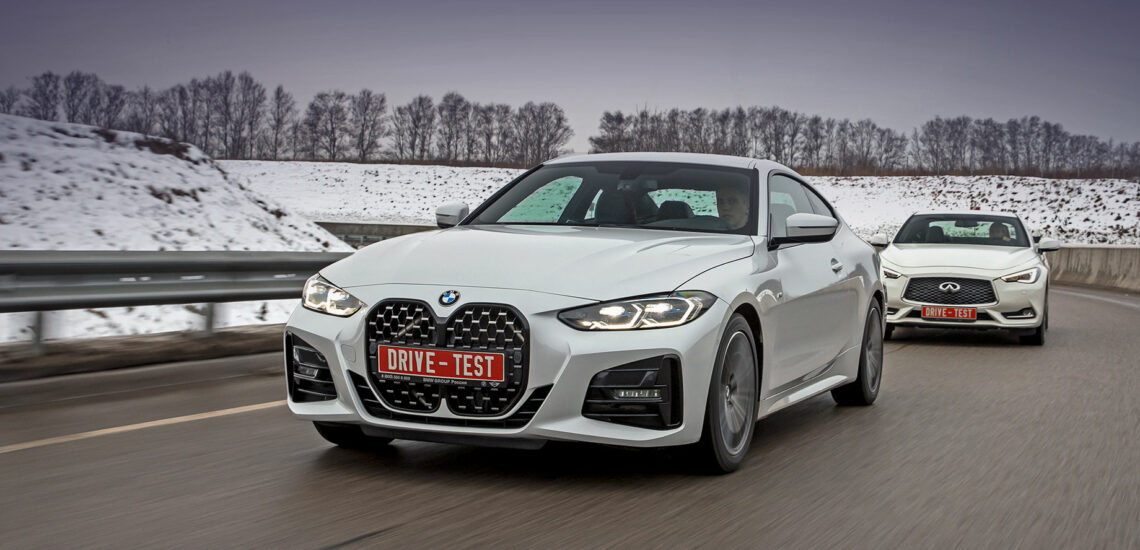There is little demand for the Q60. It is not clear why Infiniti even agreed on a test of a deliberately irrelevant model. But I am glad that it took place, because the BMW 4 Series needs context. It’s really hard to find a German competitor for it.
Although there is no Mercedes C Class in this test, its flavor is still felt here. Because, under the hood of the Q60, there is a two-liter M274 turbo engine with a capacity of 211 hp, as on the pre-facelift C 200. By the way, the bulk of Benzes in this segment are 200 hp four-wheel drives. The Infiniti has its own transmission: automatic one with seven gears, and the torque is transferred only to the back.
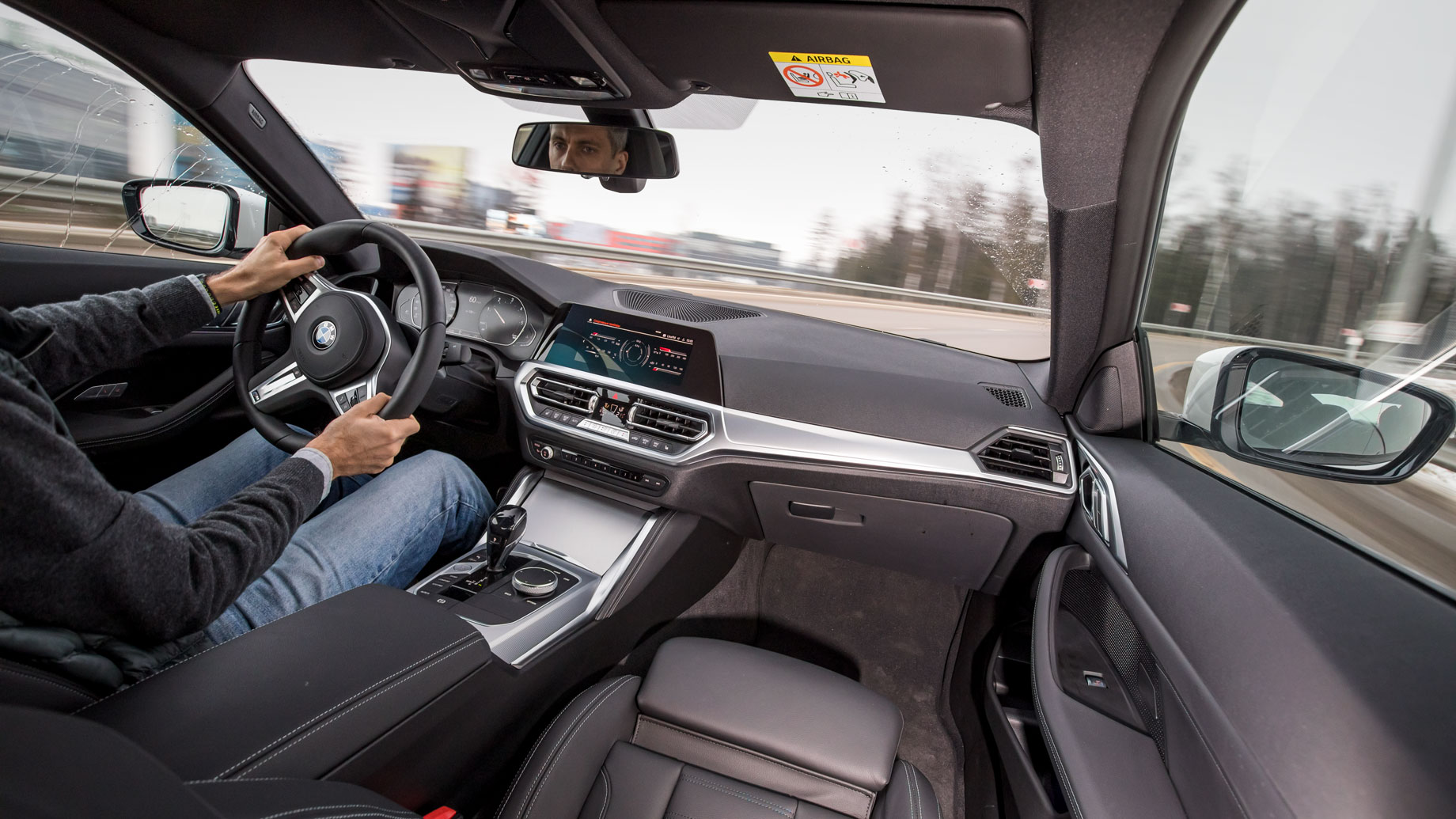
There are so many disputes about the BMW’s appearance, so much negativity in social networks! But the controversial car turned out to be twice as popular as the previously dominant Mercedes. Europe is categorical: in December 2020, 1175 BMW 4 Series and 386 Mercedes C Class cars were registered there. BMW designers have achieved the main thing – they have attracted public attention to a niche model. The Infiniti can boast neither such publicity nor magnetism for onlookers. Although, its non-aggressive image is closer to me.
Already at the stage of this test’s announcement, you asked the question: why is a 190-horsepower diesel car put up against the gasoline Q60? Not that we did it on purpose. In addition to a couple of such diesels, there is also a sub-M, the M440i xDrive, in the BMW press fleet. But that one has 387 hp. You can’t put it up even against the A5 45 TFSI. And the AMG С 43 is a piece product.
Diesel is the driving force of BMW. If you are not deterred by environmental biases, it is difficult to deny yourself the pleasure of getting 400 N-m for a ridiculous surcharge instead of the 420i initial version’s 300 with less fuel consumption. (During the test, the rear-wheel drive modification of the 420d consumed an average of 7.1 liters/100 km versus 11 liters for the Q60). Moreover, any options, including popular M packages, are available for a diesel.
However, all-wheel drive BMW cars are most in demand, and there is such a gray coupe in the representative office, shown by bloggers. But this is a matter of journalist’s personal preferences. I like to ride in winter on a rear-wheel drive, and the most interesting options seem to be close to the basic ones. A quick look at the specification is enough to choose this particular white car – there is a dashboard with needle indicator dials! Alas, the price is still steep because of the M Sport Pure package.

Let me remind you, I owned a 3 Series coupe for 11 years. Moreover, the 330i version with a naturally aspirated engine was bought exactly as a winter one. In my opinion, cars with this type of body are underestimated. There is almost no showing off in them, they are practical. It accommodates four adults, and there is more space in the back than in the large “Eight”. All their goods are in a huge trunk of the right shape. Why are there extra doors in everyday life if there are no small children?
In a word, this format, the pros and cons of the body are clear to me, I am familiar with the peculiarities of owning a BMW. For example, the irregular maintenance system is very beneficial to those who travel a little. And again, the experience of relations with the E92 generation before last is useful. The current “Four” with the G22 index returns to the same mediocre level of driving comfort after the previous soft F32 Series. Even the new 3 Series sedan has lost its smoothness, while the coupe’s suspension is even stricter, especially with the optional M package.
Instead of standard 19-inch wheels, 18-inch ones with decent studless Continental VikingContact 7 SSR tires from the factory accessories line are installed on the test “Four”. Most likely, the transition to a single size, 225/45 R18 front and rear, improves roadholding ability, but it’s unlikely that the smoothness of the ride benefits from a decrease in the diameter at rim seat. BMW engineers say that in the case of Run Flat tires, increasing the profile often harms it because of the larger area of the reinforced sidewall.
So it turns out that even on plump wheels, the “Four” transmits little things to the cabin in the most detailed way. It trembles on short waves, and at the roadway joints, it clicks with such a sound as a schoolboy’s teeth make, not sparing the enamel, when his classmates caught him in the “two for flinching” game. It finds fault with something even on a smooth highway. The years go by, tire technologies are developing – and the best recommendation to the owner of a BMW of this class is a speedy replacement of Run Flat tires with ordinary ones. Don’t be greedy and don’t wait for the regular ones to fall into disrepair – get rid of them and enjoy the transformed car.
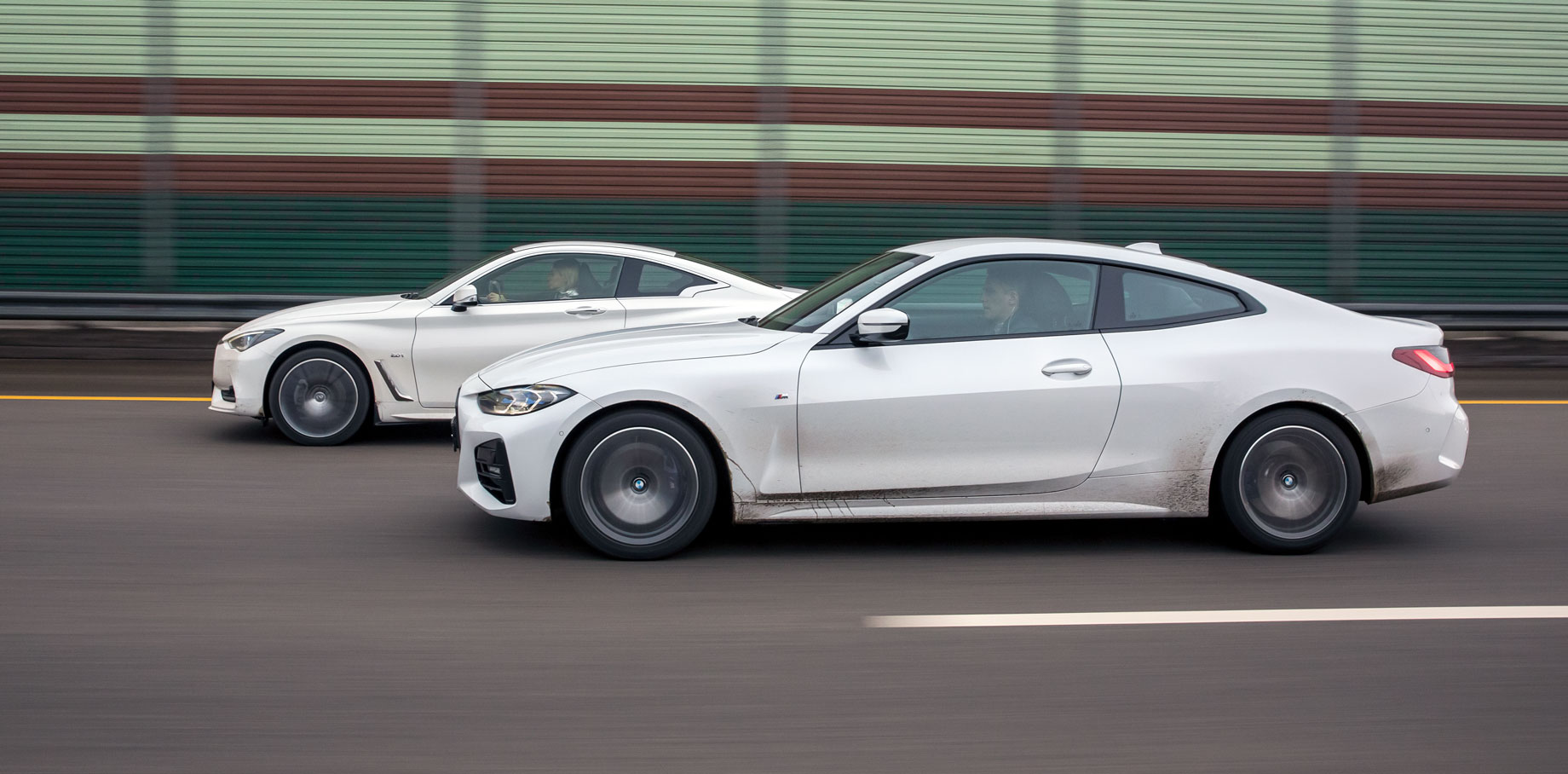
In the current state, the rigidity of the electronically controlled struts chassis is, if not excessive, then too demonstrative for an ordinary daily car. As if the chassis was adjusted to please the US market, where, as you know, there is no sportiness without shaking. However, the relatively soft “Four” of the previous generation was leading overseas among its own kind.
What happened to the fit? BMW seats never required getting used to. But new Sport seats have been developed for the G22 coupe, with which no one in the editorial office has found common ground. The backrest is too strict; something is wrong with the profile; the squab bolsters are placed wider than traditionally accepted in BMW. Rigid filler exacerbates the feeling of overstretched suspension. It is probably possible to adapt – the owners don’t complain to us. However, when choosing a car for a long journey, I get into the more cramped Q60.
The seat here is also not ideal, but it distributes the load much better. It’s a pity you can’t move the steering wheel as close to you as in the BMW. There are, however, more important problems. After the “Four”, the Infiniti interior is difficult to take seriously. While it is ergonomically more or less good, then multimedia content is not even yesterday’s, but the day-before-yesterday. No freedom was implied when ordering. The Q60 was supplied in a single configuration, so the owner is doomed to look at two low-resolution screens at once.
Despite the warning, colleagues from Infiniti equipped the car with the same Michelin X-Ice with dimension 245/40 R19. I think even if they had increased the cross section of the tires, it wouldn’t have mattered much. The way the Q60 interacts with the roadbed is determined primarily by qualitatively adjusted passive shock absorbers. The Infiniti is also not smooth. But unlike the BMW, the ride is truly sporty, devoid of tremors on trifles and the flabbiness of secondary vibrations.

The Infiniti shakes tightly on large bumps and joints, but feels more comfortable than it really is, because of the steering wheel, almost completely untied from vibrations. The Q60 doesn’t tell you anything about the disturbances of unsprung masses or how low-profile wheels hurt on potholes or tram tracks. Meanwhile, there is not the hardy McPherson here in the front, as in the BMW, but a gentle two-lever.
But there is a reverse side of the coin. The informativeness of the steering equipment with an electrohydraulic booster tends to zero. This doesn’t cause big problems in most urban modes, but the faster you drive and the more unstable the surface, the more difficult it is to catch what exactly is happening in the contact spot in a uniformly viscous force. The Infiniti is not able to synthesize feedback even in case of loss of grip by the driven wheels. The car plows in the drift, and the heaviness of the steering wheel doesn’t change.
Against this background, the very first meters behind the wheel of the “Four” are like an epiphany. Despite the gear ratio changer, the BMW electric booster is an example of informativeness after the Infiniti. The German car is significantly faster in turns, primarily due to the strong relationship with the steering wheel and the driver’s confidence in the tires, and only after that – to kinematics and elastokinematics, selected so as to provide fast responses and neutrality on the arc..
Having let the “Four” go ahead on a winding section, the Q60 will no longer catch up with it in a straight line. A slight dynamic advantage is on the BMW side. There are no ideal conditions for measurements. It’s cold, slippery, both cars are on winter tires. Racelogic shows close time readings, but the least – 7.5 seconds – belongs to the 420d. The Infiniti is heavier, its peak torque is 50 N-m lower, and it is one tenth behind at the most successful start. The average figure is slightly better for the “German”.
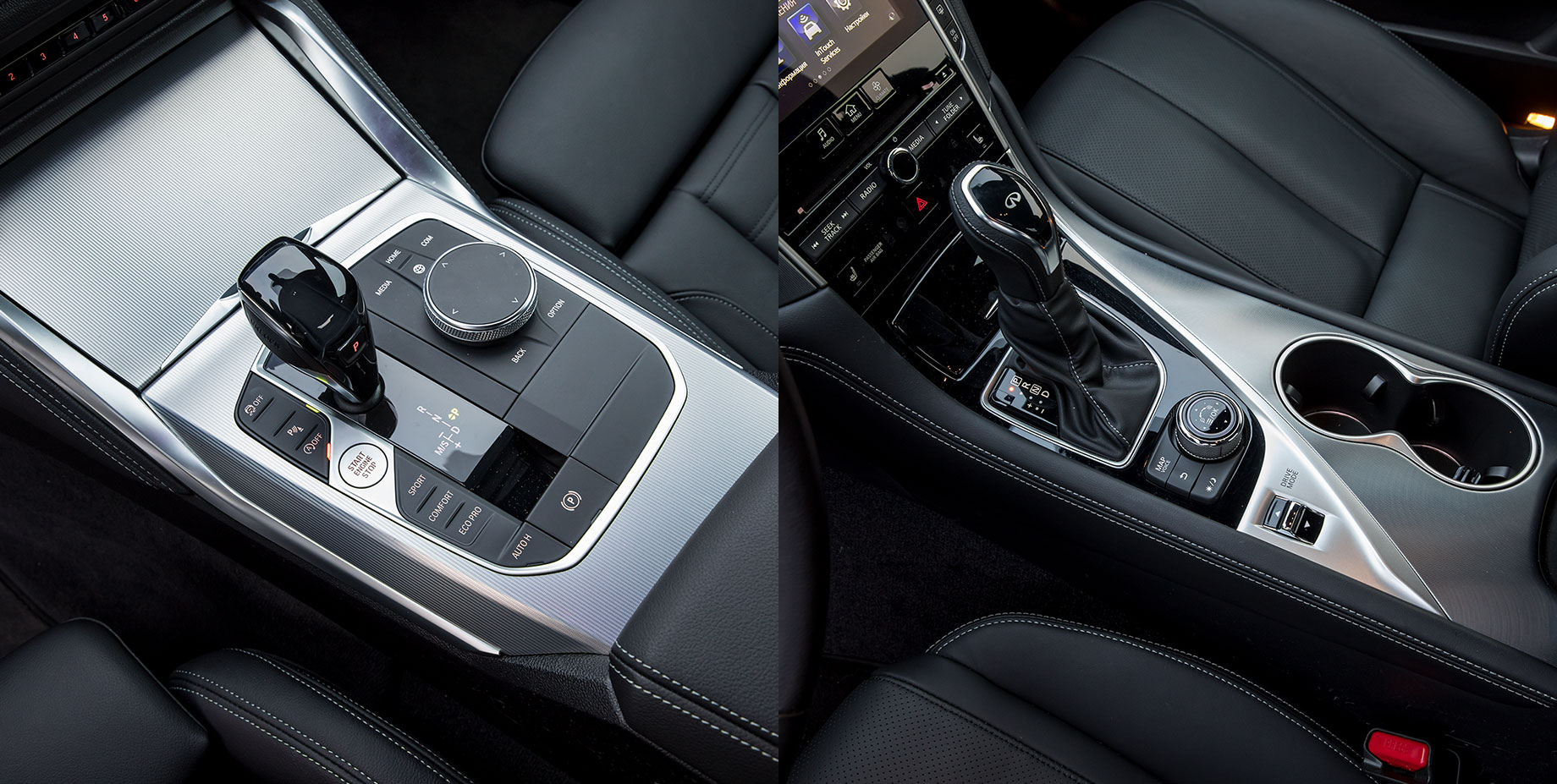
But more importantly, the BMW “Four” provides more convenient traction control. Subjectively, a modern eight-range automatic gearbox with a modified torque converter and a powerful diesel make the coupe no less responsive than my naturally aspirated six-cylinder “Three”, despite the fact that we communicated with it using a six-speed mechanical gearbox. It doesn’t sound like a compliment to the E92, but it is a clear praise for a new car.
By itself, responsiveness to fuel supply is half the battle. It’s good when it can be turned to the benefit of controllability. In order to drive in controlled conditions, we gathered at the recently rebuilt all-year-round autodrome. We were supposed to catch asphalt, but on the eve of our arrival, without warning, the track began to be flooded. Two coupes with studless tires made a difficult journey through morning traffic jams to be out on the fresh uneven ice like white cows.
It doesn’t matter. First of all, we got good photos. Secondly, a lot has become clear about gas control and chassis reactions to dynamic mass redistribution. BMW “Four” is more accurate in all responses. A minimum of time passes between the accelerator depressing and the sliding change. The “short” steering wheel simplifies the correction of skidding; its development is more stable; and the critical angle is greater due to the electronic imitation of differential lockup, which the Q60 lacks.
The Infiniti accelerator is damped at the beginning of the ride, and the turbotorque surge after 2000 rpm is difficult to control due to additional “automatic” switches. This, in particular, complicates the forward movement in traffic jams. The age-old seven-speed gearbox is generally tuned primarily to the softness of the gear change, and not to speed. Therefore, it is easier to drive the Q60 on ice at high speeds, where the gas responses are more linear, manually selecting a lowered gear. The BMW has all the jazz at the bottom and in third gear.

The Q60 steering wheel makes almost three turns between the extreme positions and requires work ahead of the curve on the ice. It’s easier to “get lost in the hands” with intensive rotation, but the price of error is lower. Search steering is acceptable – and there can be no other with such a level of feedback. You should wait for the skid under the gas discharge, and it is not a fact that you will get it – the Infiniti has a greater predisposition to drift. It is better not to fall deep: the risk of a U-turn is high. But when the rhythm is found, the Q60 stabilizes more gently when exiting the slides.
The drier the surface, the more pleasant it is to drive the Infiniti. A strange amplifier doesn’t attract attention on clean asphalt. Except that sometimes it forgets to return the steering wheel to zero when exiting slow gentle turns. The delayed turbo pickup dissolves in an eventless, but not without pleasure, acceleration to a cutoff in the zone of 6000 rpm. However, the Japanese coupe doesn’t inspire you to perform aerobatics. This is a purely urban, slow-starter car for measured movement.
Choosing the Mercedes “turbo-four” is a fatal mistake. Burdened with technical problems, the motor doesn’t please even the owners of the Q50 sedan. And here you can’t help it even with chip tuning. Only upside – it doesn’t make noise and doesn’t vibrate much, although it sounds bland. The main problem is that the M274 doesn’t rejuvenate the Q60, and the new car gives the impression of a used one – the technologies on which it relies are so outdated.
As far as I understood, the main focus in the Q60 project was on the 400-horsepower version with a V6 engine and revolutionary steering by wire. But it turned out to be too synthetic, expensive and uncompetitive. And the mass version created on the residual principle is completely devoid of character. The key that reveals the potential of the well-deserved chassis is lost. With all my love for conservative and simple solutions, the Infiniti is an example of an extremely ridiculous combination of components whose interaction only leads to environmental pollution.
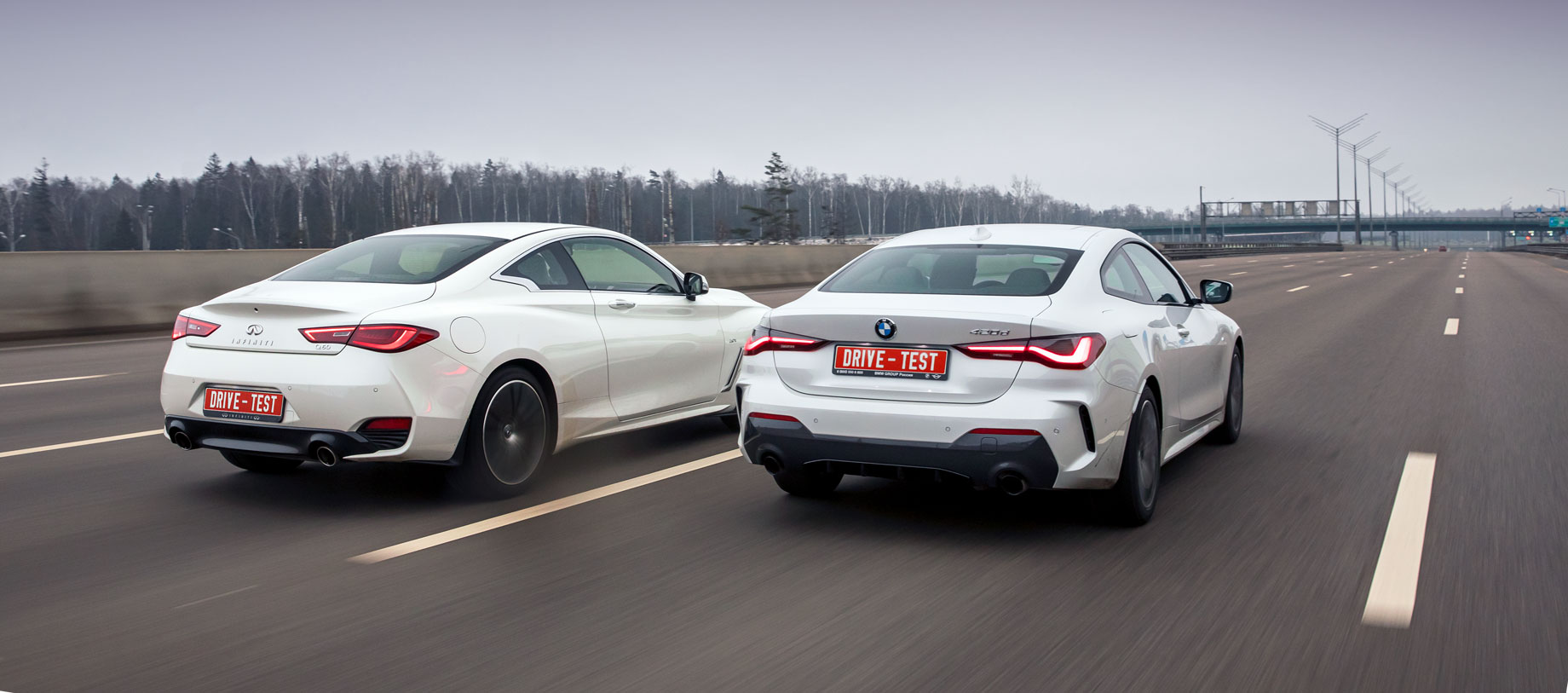
The chemistry of the 420d coupe is more productive. You get emotional, albeit a little stingy, feed from it. The two-door Bimmer is not only well-steerable, but practical and aesthetic inside. The idea of a diesel “four” for life seems sound, provided that the Run Flat tires are abandoned, or even the M-package – in favor of a chassis with conventional shock absorbers and steering mechanism. You also need to carefully approach the choice of seats. The test specification lacks harmony, although the complex dynamics exceed expectations. The closer the “four” to the basic configuration, the more adequate the price.
This is a translation. You can read the original here: https://www.drive.ru/test-drive/bmw/infiniti/5fe9e41f39b028cb85530314.html

Published July 14, 2022 • 10m to read

